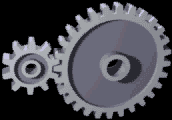Mechanical advantage
Mechanical advantage is a key concept in the field of mechanics and engineering, describing the factor by which a mechanism multiplies the force or torque applied to it. Essentially, it quantifies the efficiency with which a machine can amplify an input force to accomplish work. The principle of mechanical advantage is fundamental to the design and analysis of many types of machinery, from simple tools to complex mechanical systems.
Definition[edit | edit source]
The mechanical advantage (MA) of a machine is defined as the ratio of the output force (or load) exerted by the machine to the input force (or effort) applied. Mathematically, it is expressed as:
\[ MA = \frac{F_{\text{out}}}{F_{\text{in}}} \]
where \(F_{\text{out}}\) is the output force and \(F_{\text{in}}\) is the input force.
Types of Mechanical Advantage[edit | edit source]
There are two primary types of mechanical advantage: the Ideal Mechanical Advantage (IMA) and the Actual Mechanical Advantage (AMA).
- Ideal Mechanical Advantage (IMA) considers the machine in a perfect state, without accounting for friction or other losses. It is calculated based on the physical dimensions of the machine.
- Actual Mechanical Advantage (AMA) takes into account the real-world conditions, including friction and other efficiency losses. Consequently, AMA is always less than or equal to IMA.
Applications[edit | edit source]
Mechanical advantage is a crucial concept in the design and operation of various machines, including levers, pulleys, gears, and hydraulic systems. By understanding and applying the principles of mechanical advantage, engineers can design machines that can lift heavier loads, exert greater forces, or reduce the effort required to perform a task.
Levers[edit | edit source]
In a lever, the mechanical advantage is determined by the ratio of the lengths of the lever arms on either side of the fulcrum. The longer the arm to which the input force is applied relative to the arm that applies the output force, the greater the mechanical advantage.
Pulleys[edit | edit source]
A pulley system can achieve mechanical advantage by distributing the load across multiple ropes or chains. The more ropes supporting the load, the less force is required to lift it.
Gears[edit | edit source]
In gear systems, the mechanical advantage is determined by the ratio of the number of teeth on the driving gear to the number of teeth on the driven gear. A higher ratio means a greater mechanical advantage, allowing for the amplification of force or the increase in speed.
Hydraulic Systems[edit | edit source]
Hydraulic systems utilize the principle of mechanical advantage by transmitting force through the use of an incompressible fluid. The size difference between the pistons on either end of the system determines the mechanical advantage.
Calculating Mechanical Advantage[edit | edit source]
The calculation of mechanical advantage varies depending on the type of machine. For simple machines like levers and pulleys, it involves the ratio of distances or the number of supporting ropes. For gears, it involves the ratio of the number of teeth. In hydraulic systems, it is based on the ratio of the piston areas.
Limitations[edit | edit source]
While mechanical advantage can significantly increase the output force, it does not create energy out of nothing. According to the principle of conservation of energy, the work output of a machine cannot exceed the work input. The presence of friction and other losses further reduces the actual output.
Conclusion[edit | edit source]
Understanding mechanical advantage is essential for the design and analysis of machines and mechanisms. By optimizing the mechanical advantage, engineers can create more efficient and effective machines, thereby expanding the capabilities of human technology.
Search WikiMD
Ad.Tired of being Overweight? Try W8MD's physician weight loss program.
Semaglutide (Ozempic / Wegovy and Tirzepatide (Mounjaro / Zepbound) available.
Advertise on WikiMD
|
WikiMD's Wellness Encyclopedia |
| Let Food Be Thy Medicine Medicine Thy Food - Hippocrates |
Translate this page: - East Asian
中文,
日本,
한국어,
South Asian
हिन्दी,
தமிழ்,
తెలుగు,
Urdu,
ಕನ್ನಡ,
Southeast Asian
Indonesian,
Vietnamese,
Thai,
မြန်မာဘာသာ,
বাংলা
European
español,
Deutsch,
français,
Greek,
português do Brasil,
polski,
română,
русский,
Nederlands,
norsk,
svenska,
suomi,
Italian
Middle Eastern & African
عربى,
Turkish,
Persian,
Hebrew,
Afrikaans,
isiZulu,
Kiswahili,
Other
Bulgarian,
Hungarian,
Czech,
Swedish,
മലയാളം,
मराठी,
ਪੰਜਾਬੀ,
ગુજરાતી,
Portuguese,
Ukrainian
Medical Disclaimer: WikiMD is not a substitute for professional medical advice. The information on WikiMD is provided as an information resource only, may be incorrect, outdated or misleading, and is not to be used or relied on for any diagnostic or treatment purposes. Please consult your health care provider before making any healthcare decisions or for guidance about a specific medical condition. WikiMD expressly disclaims responsibility, and shall have no liability, for any damages, loss, injury, or liability whatsoever suffered as a result of your reliance on the information contained in this site. By visiting this site you agree to the foregoing terms and conditions, which may from time to time be changed or supplemented by WikiMD. If you do not agree to the foregoing terms and conditions, you should not enter or use this site. See full disclaimer.
Credits:Most images are courtesy of Wikimedia commons, and templates, categories Wikipedia, licensed under CC BY SA or similar.
Contributors: Prab R. Tumpati, MD




